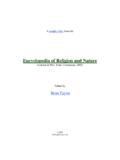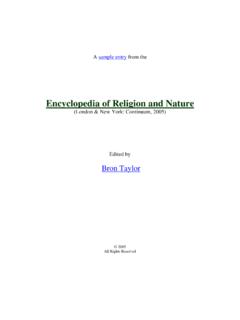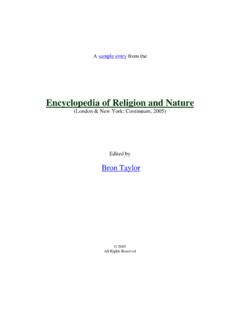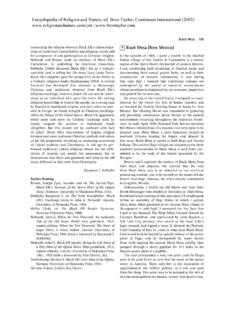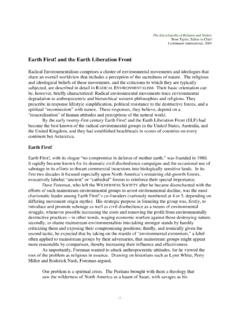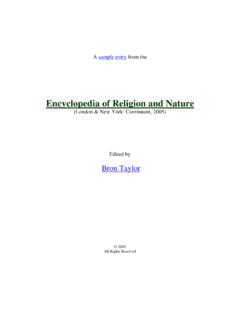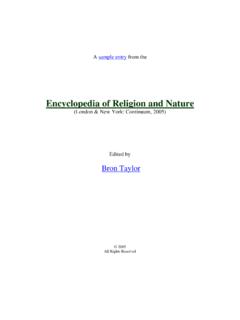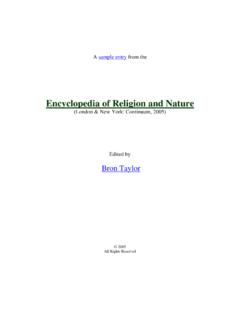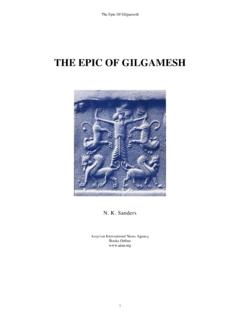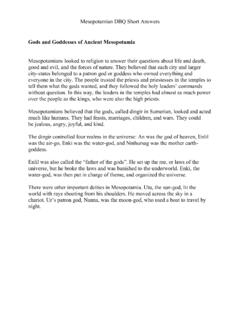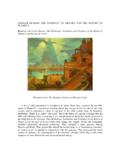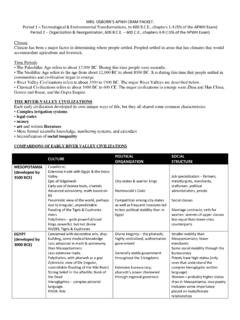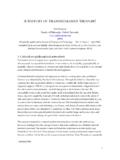Transcription of Creation Myths of the Ancient World - Website for …
1 Members of a proud but often desperately marginal sub-culture, real cowboys often have lives that are consider-ably sadder and less romantic than the mythology of cow-boy culture would suggest. Still, these real men and boys,and some women as well, write and resonate with thepoetry that idealizes their PorterfieldFurther ReadingCannon, Hal, ed. Cowboy Poetry: A Gathering. Layton, UT:Gibbs M. Smith, Inc., , Gretel. The Solace of Open Spaces. New York:Penguin Books, , Richard. Regeneration through Violence: TheMythology of the American Frontier, 1600 , CT: Wesleyan University Press, , Henry Nash. Virgin Land: The American West asSymbol and Myth. Cambridge: Harvard UniversityPress, 1973 (1950).Stanley, David and Elaine Thatcher, eds. Cowboy Poets &Cowboy Poetry. Urbana: University of Illinois Press, also: Bison Restoration and Native AmericanTraditions; Disney Worlds at War; Manifest Myths of the Ancient WorldCreation Myths in Egypt, Mesopotamia, and Greece gener-ally express the idea of the Creation and defense of anordered cosmos from out of primordial chaos.
2 Manyconnections can be made among these different mythictraditions in their attempts to make sense of the naturalworld. For example, the idea of water as the primordialsource of life can be found in all of these traditions. More-over, water is then used by the gods to punish and purifyin the Gilgamesh epic of Mesopotamia (ca. 2000 ), in Greek stories of Zeus (the weather-god), andeven in the Hebrew story of Genesis. Here we seemyth struggling to comprehend the moral purpose of thedestructive power of nature. There are many other connec-tions among mythic motifs, including the bull as a symbolof fertility and power, stories about the struggles of thesun-god to maintain the order of day, and stories aboutthe divine origin of the cycle of the seasons. One mustbe careful, when undertaking such a synthetic approach,however, because these mythological traditions each havetheir own integrity. And even within a single traditionthere are conflicting stories and rival complexity of the mythologies of Mesopotamiareflects the linguistic and political diversity of this of the better-known and more recent texts in thistradition are the epic of Gilgamesh and the Enuma Elish(ca.)
3 2000 1200 ), the Babylonian Creation epic. Butthere are other Creation stories, which make use of the sameor similar gods and goddesses. Older Mesopotamian cos-mogonies focused on various nature gods including: Anor Anu, the sky-god; Enlil, the wind-god who originallyseparated sky from Earth; and Ea or Enki, the creator godwho came from out of the primordial waters to createlife on land. This pantheon also included the sun-god,Shamash, and the mother-goddess, Ninhursaga. Theseolder Sumerian stories tend to make the Creation event anatural occurrence in which the primordial abyss, Apsu orAbzu, was opened and the World was created accordingto principles of natural order. That these gods representedorder and justice in the cosmos is illustrated by the sun-god, Shamash, who gave Hammurabi his famous code oflaws (ca. 1700 ). A recurrent theme in these earlymyths is the struggle of the gods of order against chaoticmonsters who rise out of Apsu s abysmal depths.
4 Thestandard interpretation traces this struggle of cosmosagainst chaos in Mesopotamian myth to the unpredict-ability of the Tigris-Euphrates river cosmogony of the Enuma Elish presents a creationstory in which this struggle against such violent destruc-tive forces predominates. In this story we find the triumphof a younger god, Marduk, in his struggle against thechaotic primordial waters, the male Apsu, now represent-ing fresh water, and the female Tiamat, who represents thesalt water. The other gods arise from out of Tiamat who isimpregnated by Apsu, in a symbolic representation of thedeposition of silt in the delta. In the course of this story thenoisy and active younger gods anger the static tranquilityof Apsu and Tiamat. A cycle of violence ensues and finallyMarduk, the noisy young upstart, leads the gods in a finaldecisive battle against Tiamat. Marduk defeats Tiamat andsplits her body, creating heaven and Earth.
5 Along the wayMarduk also slays Kingu, Tiamat s champion. Mardukordains that human beings are to be created out of Kingu sblood. In one version, when Tiamat is slain, her body isopened and the waters flow out through various Tigris and Euphrates flow out of her eyes and her bodybecomes the mountains from which these waters danger of her overflowing flood is always present andreligious rituals are used to prevent this threat of moral of these Mesopotamian Myths is that thehuman being is a minor and inconsequential portion ofa much larger struggle within the natural World . Theprimeval Creation scene focuses on the coming of orderout of nothing and the struggle of order against Creation of human beings comes later. Indeed, theMesopotamian Myths profess that human beings arecreated to suffer and die as servants of the gods. TheMesopotamian gods are, for the most part, indifferent tohuman suffering.
6 When they do intervene in humanaffairs they do so for their own Myths of the Ancient World 431 Certain natural themes are ubiquitous in the Mesopo-tamian Myths . One of the most important of these themesis water. Life is said to have come from water and can see here an obvious connection with the naturalenvironment of Mesopotamia where flooding and siltdeposition were pressing concerns of early agricultural-ists. The importance of water recurs in the Gilgameshepic with the story of the flood as told to Gilgamesh by theimmortal one, Utnapishtim. The gods destroyed humanityby way of the flood because the raucous noise madeby human beings on Earth was disturbing to their himself struggles through and across waters tofind the immortal one who then directs him to a medicinethat can ensure youthful longevity. This medicinal plantis found under water and is later lost by Gilgamesh whena snake comes out of a well and steals it from him.
7 Inthe Gilgamesh, water is the important element againstwhich human beings must struggle. This struggle does notpromise a happy ending, however, as the waters them-selves seem to be poised against human success. Humaninteraction with nature is thus humans struggled before indifferent gods to subduenature in the Mesopotamian stories, in Egypt they wereseen as allies of the gods in their struggle to maintainorder before the forces of chaos. Unlike the precariousand dangerous cosmos of the Mesopotamian stories, theEgyptian cosmogonies seem to hold out the hope for sta-bility and immortality. The Egyptian idea of the primordialnothingness was personified as Nun, waters which areinert and featureless. These waters are not like angryMesopotamian Tiamat. For the Egyptian, the cycle of timewas stable, as represented by the movement of the sunacross the sky and the regular cycle of the floodingNile. There was a promise of stability and permanence,even though there were dangers and monsters to Egyptian Creation stories begin when Atum or Re,the first god, comes into existence.
8 His appearance occursin the same way that a hill might be revealed by the reced-ing floodwaters of the Nile. This naturalistic metaphor hastwo important aspects for Egyptian mythology. First,Egyptians tried to locate the point of Atum s appearanceat some definite geographical high point, which was thensanctified as a center of religious or political , as the Egyptian tradition developed in differentcultural centers (Heliopolis, Memphis, or Hermopolis, forexample) the geographical location of this holy groundalso shifted. Second, it connects the Creation myth withthe seasonal fluctuation of the Nile and so locates theEgyptian mythology within the natural World . Thisseasonal ebb and flow, the concealing and revealing ofland, may also have been the basis of Egyptian ideas aboutreincarnation, as seen in the myth of Osiris. In general, theEgyptian cosmogony appealed to certain basic facts ofEgyptian climate and naturalistic elements occur in the Egyptianmythos, including the idea of the generation of the worldfrom a primordial act of divine masturbation or expectora-tion, as Atum brought the World into existence fromout of himself.
9 This idea develops in a more intellectualdirection, with connections to the Hebrew Creation story,in which the creator god of the Memphis theogony, Ptah,speaks the word into existence. There is also a parallelstory featuring the spontaneous generation of frogs andsnake from out of the mud left by the receding flood-waters. This naturalistic theme was taken up in earnest bythe cosmogony of Hermopolis, which was a city locatedmidway between Thebes and Memphis. In the Hermopoli-tan cosmogony the cosmic egg either laid by a cacklinggoose, an ibis, or simply left by the receding this egg was the sun-god, Re, who then created therest of the World . Finally, there were stories about theappearance of the divine flower, the lotus, growing outof the sacred lake at Hermopolis. This flower was againidentified with the sun god. Other significant naturalthemes can be found in the animal imagery of thesemyths. The god Horus was connected with the falcon,which was connected with the sun, the falcon s eye in thesky.
10 In addition, the sun god was connected with the bullas a symbol of fertility and strength and the cow as asymbol of generation and naturalistic themes in the Egyptian cosmogonymake sense within the geographical context of the Nilesystem. The cyclical floods of the river, the repetitionof cycles and seasons in the natural World showed theEgyptians a concrete example of Creation on a yearlybasis. Creation occurred in the appearance of land, of thesun, the cycles of the moon, in the genesis of amphibianlife, of eggs, and in the birth of the lotus from out of thenothing that was the primordial water of the river and ofNun. The Egyptian concern with immortality and rebirth,its connection with a stable natural World , its worship ofthe sun-god, and its cult of the pharaoh (who was in somestories the reincarnation of Osiris and thus a descendent ofRe) all of this is connected with the geographical contextand its tendency to support these naturalistic explanationsfor the existence of the World .
